About the Church
 |
 |
 |
 |
 |
 |
 |
The Holy Mass - Part VI
Progressivism & Protestantism:
Disturbing Similarities
By changing the way Catholics world-over pray – lex orandi – the Conciliar Revolution has effectively changed the way the people believe – lex credendi.
What we have witnessed in the last 50 years is a general and systematic destruction of the Church, one that has been demonstrated amply by Atila Guimarães in his Collection Eli, Eli, Lamma Sabacthani? on Vatican II. In it he shows the Council’s plan – implemented by all the post-Vatican II Popes – to destroy the 2,000-year-old Dogma, Morals, Liturgy and traditions of the Holy Church. (1)
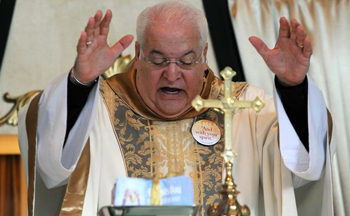 Regarding the Holy Mass, a slow gradual process of alteration of the Tridentine Mass was carried out stealthily and steadily from 1963 to 1969, as seen
before. The average Catholic went along with the changes, gradually mesmerized into acceptance by the Bishops and priests he had been taught to trust and obey.
Regarding the Holy Mass, a slow gradual process of alteration of the Tridentine Mass was carried out stealthily and steadily from 1963 to 1969, as seen
before. The average Catholic went along with the changes, gradually mesmerized into acceptance by the Bishops and priests he had been taught to trust and obey.
Unfortunately, most of the Clergy as well as lay Catholics in general knew little about Dogmatic Theology and did not protest changes to the perennial and immutable Church teaching. Other Bishops and priests, who noticed the contradictions, went along with them in order not to lose their careers.
An analogous scenario took place in England when the Anglican heresy was installed in the 16th century.
It has been a common habit among heretics throughout History to use the liturgy in order to introduce their errors. Remarking on this practice adopted by the Protestant Revolution, Pope Leo XIII warns in the Encyclical Apostolicae curae :
“They knew only too well the intimate bond that unites faith with worship, the law of belief with the law of prayer. … Under the pretext of restoring the order of the liturgy to its primitive form, they corrupted it in many respects to adapt it to the errors of the Innovators.” (2)
Despite that warning, under the command of Paul VI and based on Vatican II, the Tridentine Mass was replaced by a new rite completely in tune with Protestantism. The New Mass in fact has many similarities to the heretic Thomas Cranmer’s Anglican “Communion Service.” (3)
A concordance with Protestantism
In 1549, on behalf of the Anglican Sect, Cranmer issued a Book of Common Prayer to instruct its priests and bishops on the liturgy and how to minister its sacraments.
When we compare the Communion Service in this 1549 Anglican Book with Paul VI’s Novus Ordo Missae of 1969, we find many disturbing similarities:
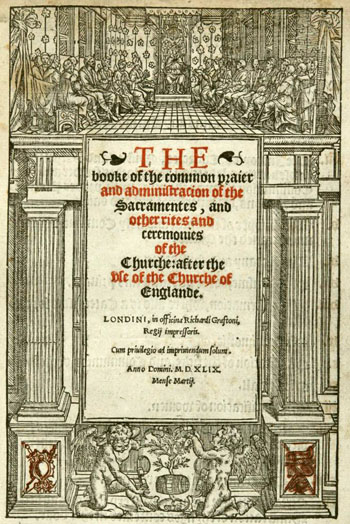 1. The first aim of Cranmer's Book of Common Prayer was the substitution of Latin by English on the pretext that Latin was not understood by the faithful.
1. The first aim of Cranmer's Book of Common Prayer was the substitution of Latin by English on the pretext that Latin was not understood by the faithful.
Sadly, Paul VI substituted Latin by the vernacular alleging the same motive of comprehensibility, acting on the Council’s declaration that the new rite is endowed with a new vigor to suit the needs and circumstances of the present day.
2. The term Holy Mass was changed: The Book of Common Prayer adopted the term “The Lord’s Supper,” or simply the “Communion Service.”
After Paul VI’s liturgical reform, there was no more talk of the Holy Mass or the Sacrifice of the Mass. The term Mass was replaced by “the Eucharist,” “the Lord’s Supper" or the “Celebration.”
3. The Prayers at the foot of the altar were suppressed in the Anglican Communion Service.
In the Novus Ordo these prayers were also eliminated.
4. Greater emphasis was given in the Anglican Service to Scripture readings, sermons and commentaries.
In like manner, the New Mass greatly expanded the “Liturgy of the Word” and the role of the laity in the “service.”
5. At the Offertory of the bread and wine, Cranmer suppressed all the prayers that made it clear that they were to become the real Body and Blood of Our Lord, which he called a “very horrible heresy” of the Catholic Church. For him the sacramental presence of Christ was simply figurative and, therefore, it was erroneous to speak of a renewal of Christ’s sacrifice on the Holy Altar.
In the Novus Ordo Missae, all the prayers and rubrics emphasizing that the Bread and Wine are to be transubstantiated into the Body and Blood of Christ were eliminated: e.g. Suscipe Sancte Pater, Offerimus tibi, Domine calicem salutaris.
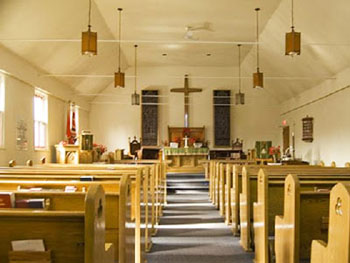
 Also suppressed is the priest placing the Host on the corporal (which emphasizes the reality of the Body), after he makes the Sign of the Cross with the Host (a reminder of the immolation) and the supplication to the Holy Ghost to effect the renewal of the Sacrifice of the Cross (i.e. Veni Sanctificator). These suppressions echo as well the spirit of Luther, who likewise denied the sacrificial nature of the Mass.
Also suppressed is the priest placing the Host on the corporal (which emphasizes the reality of the Body), after he makes the Sign of the Cross with the Host (a reminder of the immolation) and the supplication to the Holy Ghost to effect the renewal of the Sacrifice of the Cross (i.e. Veni Sanctificator). These suppressions echo as well the spirit of Luther, who likewise denied the sacrificial nature of the Mass.
6. On the other hand, the prayers kept by Cranmer – the Preface, Sanctus and Benedictus – were also retained in the Novus Ordo Missae.
7. Cranmer had no use for the prayers commemorating the Blessed Virgin and the Saints in the Canon, so did away them. He also eliminated the prayers that preceded the Consecration, where the priests asks God to bless, accept and sanctify the oblations so that they “may become for us the Body and Blood of Thy Most Beloved Son Jesus Christ Our Lord.” Again, this suppression was made to deny the doctrine of Transubstantiation and the sacrificial character of the Mass, which the Protestants have always rejected.
Cranmer called “the final end of all this Antichrist's doctrine [on Transubstantiation] the greatest idolatry that ever was devised in this world.” (4) Luther also announced his rejection of it, stating that the priest's task of offering the sacrifice of the Mass was “a perversion, for Christ had offered himself once for all.” (5)
As the name implies, the “Canon” (from the Greek kanon = model, standard) was the invariable part of the Mass regarded as untouchable. Hence Paul VI’s reform was carried out cautiously. As explained before, in the Novus Ordo Missae four new Eucharistic prayers were introduced. The first simulated the Roman Canon with some minor changes; the three new ones made substantial changes and omissions, eliminating the traditional concept of oblation in agreement with the words of Cranmer and Luther.
Should we be surprised when we recall that six Protestant ministers helped to craft the New Mass?
8. Finally, we come to the Consecration. The matter of leaving out the words “Mysterium Fidei” from the formula (6) for consecrating the wine into the Divine Blood of Christ has already been discussed before. It suffices here to note that in this case also the New Mass is following in Cranmer’s footsteps.
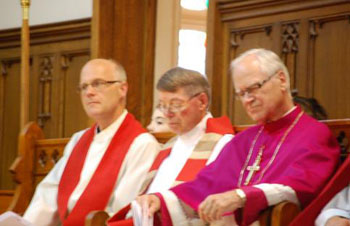 As for the eucharistic prayers, we find this formula in the Book of Common Prayer, “Grant that by the power of your Holy Spirit these gifts of bread and wine may be to us his body and his blood.” These are almost word for word what we find in the Novus Ordo Missae of Paul VI.
As for the eucharistic prayers, we find this formula in the Book of Common Prayer, “Grant that by the power of your Holy Spirit these gifts of bread and wine may be to us his body and his blood.” These are almost word for word what we find in the Novus Ordo Missae of Paul VI.
Cranmer's admitted purpose for this wording was to confute the doctrine of transubstantiation. He called the new teaching – that Our Lord was only “spiritually present” at the Eucharist – “the true and Catholic doctrine” expressed in liturgy.(7)
One can only wonder at the intent of the framers of the Novus Ordo Missae, who followed the Protestants so carefully in the making of the New Mass. It would certainly seem that, for these “reformers” also, the “true Sacrifice of the New Covenant” is but a mere memorial.
The majority of the prayers of the Latin Mass were either eliminated or drastically altered. To give but some examples:
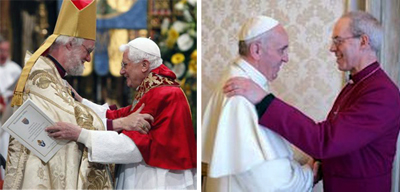 Continued
Continued

What we have witnessed in the last 50 years is a general and systematic destruction of the Church, one that has been demonstrated amply by Atila Guimarães in his Collection Eli, Eli, Lamma Sabacthani? on Vatican II. In it he shows the Council’s plan – implemented by all the post-Vatican II Popes – to destroy the 2,000-year-old Dogma, Morals, Liturgy and traditions of the Holy Church. (1)

Most priests placidly went along with the changes to keep their comfortable positions
Unfortunately, most of the Clergy as well as lay Catholics in general knew little about Dogmatic Theology and did not protest changes to the perennial and immutable Church teaching. Other Bishops and priests, who noticed the contradictions, went along with them in order not to lose their careers.
An analogous scenario took place in England when the Anglican heresy was installed in the 16th century.
It has been a common habit among heretics throughout History to use the liturgy in order to introduce their errors. Remarking on this practice adopted by the Protestant Revolution, Pope Leo XIII warns in the Encyclical Apostolicae curae :
“They knew only too well the intimate bond that unites faith with worship, the law of belief with the law of prayer. … Under the pretext of restoring the order of the liturgy to its primitive form, they corrupted it in many respects to adapt it to the errors of the Innovators.” (2)
Despite that warning, under the command of Paul VI and based on Vatican II, the Tridentine Mass was replaced by a new rite completely in tune with Protestantism. The New Mass in fact has many similarities to the heretic Thomas Cranmer’s Anglican “Communion Service.” (3)
A concordance with Protestantism
In 1549, on behalf of the Anglican Sect, Cranmer issued a Book of Common Prayer to instruct its priests and bishops on the liturgy and how to minister its sacraments.
When we compare the Communion Service in this 1549 Anglican Book with Paul VI’s Novus Ordo Missae of 1969, we find many disturbing similarities:

Paul VI's New Mass follows closely along with Cranmer's revolutionary changes
Sadly, Paul VI substituted Latin by the vernacular alleging the same motive of comprehensibility, acting on the Council’s declaration that the new rite is endowed with a new vigor to suit the needs and circumstances of the present day.
2. The term Holy Mass was changed: The Book of Common Prayer adopted the term “The Lord’s Supper,” or simply the “Communion Service.”
After Paul VI’s liturgical reform, there was no more talk of the Holy Mass or the Sacrifice of the Mass. The term Mass was replaced by “the Eucharist,” “the Lord’s Supper" or the “Celebration.”
3. The Prayers at the foot of the altar were suppressed in the Anglican Communion Service.
In the Novus Ordo these prayers were also eliminated.
4. Greater emphasis was given in the Anglican Service to Scripture readings, sermons and commentaries.
In like manner, the New Mass greatly expanded the “Liturgy of the Word” and the role of the laity in the “service.”
5. At the Offertory of the bread and wine, Cranmer suppressed all the prayers that made it clear that they were to become the real Body and Blood of Our Lord, which he called a “very horrible heresy” of the Catholic Church. For him the sacramental presence of Christ was simply figurative and, therefore, it was erroneous to speak of a renewal of Christ’s sacrifice on the Holy Altar.
In the Novus Ordo Missae, all the prayers and rubrics emphasizing that the Bread and Wine are to be transubstantiated into the Body and Blood of Christ were eliminated: e.g. Suscipe Sancte Pater, Offerimus tibi, Domine calicem salutaris.

Today nothing differentiates an Anglican temple, above, from a modern Catholic church, below

6. On the other hand, the prayers kept by Cranmer – the Preface, Sanctus and Benedictus – were also retained in the Novus Ordo Missae.
7. Cranmer had no use for the prayers commemorating the Blessed Virgin and the Saints in the Canon, so did away them. He also eliminated the prayers that preceded the Consecration, where the priests asks God to bless, accept and sanctify the oblations so that they “may become for us the Body and Blood of Thy Most Beloved Son Jesus Christ Our Lord.” Again, this suppression was made to deny the doctrine of Transubstantiation and the sacrificial character of the Mass, which the Protestants have always rejected.
Cranmer called “the final end of all this Antichrist's doctrine [on Transubstantiation] the greatest idolatry that ever was devised in this world.” (4) Luther also announced his rejection of it, stating that the priest's task of offering the sacrifice of the Mass was “a perversion, for Christ had offered himself once for all.” (5)
As the name implies, the “Canon” (from the Greek kanon = model, standard) was the invariable part of the Mass regarded as untouchable. Hence Paul VI’s reform was carried out cautiously. As explained before, in the Novus Ordo Missae four new Eucharistic prayers were introduced. The first simulated the Roman Canon with some minor changes; the three new ones made substantial changes and omissions, eliminating the traditional concept of oblation in agreement with the words of Cranmer and Luther.
Should we be surprised when we recall that six Protestant ministers helped to craft the New Mass?
8. Finally, we come to the Consecration. The matter of leaving out the words “Mysterium Fidei” from the formula (6) for consecrating the wine into the Divine Blood of Christ has already been discussed before. It suffices here to note that in this case also the New Mass is following in Cranmer’s footsteps.

Three bishops – two Catholic and one Anglican – at an ecumenical service in York Minister
Cranmer's admitted purpose for this wording was to confute the doctrine of transubstantiation. He called the new teaching – that Our Lord was only “spiritually present” at the Eucharist – “the true and Catholic doctrine” expressed in liturgy.(7)
One can only wonder at the intent of the framers of the Novus Ordo Missae, who followed the Protestants so carefully in the making of the New Mass. It would certainly seem that, for these “reformers” also, the “true Sacrifice of the New Covenant” is but a mere memorial.
The majority of the prayers of the Latin Mass were either eliminated or drastically altered. To give but some examples:
- Unde et memores;
- Supplices te fogamus;
- Nobis Quoque peccatoribus;
- Libera nos quaesumus;
- Agnus Dei;
- Domine Jesu Christi (two);
- Perceptio Corporis;
- Misereatur vestre;
- Indulgentium;
- the Communion and the Postcommunion Antiphon;
- the Last Gospel of St. John and
- the Leonine Prayers.

Benedict & Francis embracing the archbishops of Canturbury (Williams & Welby) to promote ecumenism
- 1. See especially Animus Injuriandi I and Animus Injuriadi II (Desire to Injure) and Animus Delendi I (Desire to Destroy) and Animus Delendi II.
- Encyclical Apostolicae Curae promulgated September 18, 1896, n. 30.
- This article references the following works: "Special Issue on the Holy Mass" by Fr. Noel Barbara, Fortes in Fide, vol. 1, n. 4, 1975.
- D.A. Scales, "Thomas Cranmer’s ‘True and Catholick Doctrine of the Sacrament'" Churchman 104/2 1990.
- Martin Brecht, Martin Luther: Shaping and Defining the Reformation, 1521-1532, Fortress Press, 1990, pp. 28-30.
- In the Novus Ordo, one of the many formulae to replace the Mystery of Faith is this banal phrase: Christ has died, Christ is risen, Christ will come again.
- D.A. Scales, "True and Catholick Doctrine," p. 1.

Posted November 13, 2015














